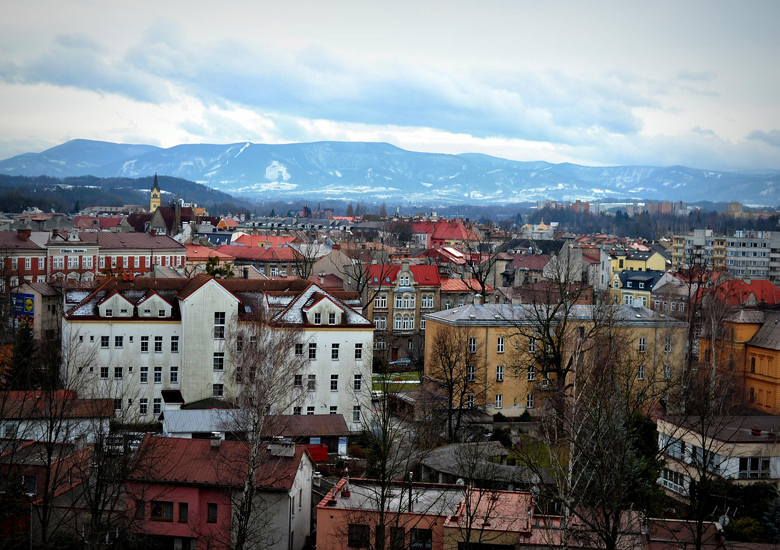Cieszyn is a border town in southern Poland on the east bank of the Olza River, and the administrative seat of Cieszyn County, Silesian Voivodeship. The town has about 36,100 inhabitants (as of 2013), and lies opposite Cesky Tesin in the Czech Republic’s Karvina District, Moravian-Silesian Region. Both towns belonged to the historical region of Austrian Silesia and are the historical capital of the region of Cieszyn Silesia. History : The area has been populated by Slavic peoples since at least the 7th century. According to legend, in 810 three sons of a prince – Bolko, Leszko and Cieszko, met here after a long pilgrimage, found a spring, and decided to found a new settlement. They called it Cieszyn, from the words cieszym sie (“I’m happy”). This well can be found at ulica Trzech Braci (“Three Brothers Street”), just west of the town square.
The town was the capital of the Duchy of Teschen since 1290, which was ruled by Piast dynasty until 1653 and by the Habsburg Dynasty of Austria to 1918. It was in Teschen that Maria Theresa and Frederick II on in May 1779 signed the Teschen Peace Treaty, which put an end to the War of the Bavarian Succession. In the 19th century Teschen was known for its ethnic, religious and cultural diversity, containing mostly German, Polish, Jewish and Czech communities. There was also a small Hungarian community in the town consisting mostly of officers and clerks.
The town was divided in July 1920, by the Spa Conference, a body formed by the Versailles Treaty, leaving a Polish minority on the Czechoslovak side. Its smaller western suburbs became what is now the town of Cesky Tesin in the Czech Republic. During the interwar period two villages were merged into Cieszyn: Blogocice in 1923 and Bobrek in 1932. After 1920 many ethnic Germans left the town, while many Poles from the Czechoslovakian part of the region moved in. According to the Polish census of 1921, Cieszyn had 15,268 inhabitants, of whom 9,241 (60,5%) were Poles, 4,777 (31,2%) were Germans, 1014 (6,6%) were Jews, and 195 (1,3%) were Czechs. The census from 1931 indicated 14,707 inhabitants, of whom 12,145 (82,7%) were Poles, while the rest consisted mostly of Germans and Jews (in 1937 estimated to be 12 and 8% respectively).
Cieszyn and Cesky Tesin were merged again in October 1938 when Poland annexed the Zaolzie area together with Cesky Tesin. In 1939 Cieszyn Silesia was occupied by German forces and during World War II it was part of Nazi Germany. Almost the entire Jewish community was murdered by the Nazis. After World War II, the border between Poland and Czechoslovakia was restored to that of 1920. Most Germans fled or were expelled and were replaced with Poles expelled from the Polish areas annexed by the Soviet Union. Signs of the former German presence in the town were obliterated by a special committee. On 19 July 1970, five firefighters from Cieszyn died when a bridge they were on fell into the Olza River, due to heavy flooding. In 1977, Boguszowice, Guldowy, Kalembice, Krasna, Mnisztwo, Pastwiska were amalgamated with Cieszyn and Marklowice.
Access : Coordinates: 49.748436, 18.633211 / Bus services depart Krakow and Katowice regularly from the main bus stations in those cities. The 1 Cieszyn bus station is located a bit north of the old town. Right next to it is the 2 Cieszyn railway station. If arriving from Czech Republic or Slovakia, it is best to get a train to Cesky Tesin and walk across the bridge.
Attractions : Old Town Square (Rynek) with bourgeoisie houses and Town Hall (Ratusz)
1 Cieszyn Castle, Zamkowa 3. Su-F: 9:00—17:00. Closed on Sa. Remnants: Piast Castle Tower, Gothic St. Mary Magdalene Church, Romanesque St. Nicholas’ Chapel (11th century rotunda) 2 Museum of Cieszyn Silesia, ul. Tadeusza Regera 6. In the former Larisch palace (Palac Laryszow, Muzeum Slaska Cieszynskiego). The oldest continuously working museum in Poland, opened in 1802. 16 PLN.
3 Museum of Typography (Muzeum Drukarstwa), ul. Gleboka 50 . Tue-Fri 10-17, from may-september also on Sat-Sun 14-18. 10 PLN incl. tour.
4 Rotunda of Saint Nicholas, Zamkowa. A Romanesque rotunda built in the 12th century. It used to be a castle chapel and a stronghold church. This rotunda is also the one that can be seen on the 20 zl banknotes
Activities : Polish Theatre (Teatr im. Adama Mickiewicza), Plac Teatralny 1, 2 Czech Theatre, Ostravska 1326/67, 737 01 Cesky Tesin, Events : No Border Festival.
Cinema On The Border. Film festival
Go next : Bielsko-Biala / Ski-sport towns, such as Szczyrk, Wisla, Ustron and Zywiec / Ostrava, Czech Republic

